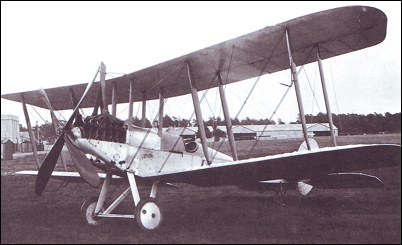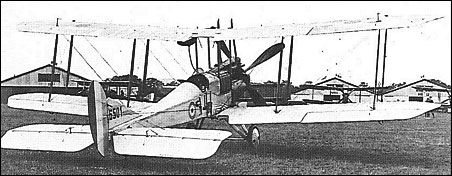|
| Evolved at Farnborough during 1915 as a marriage of
the B.E.2c airframe with the then-new R.A.F.4 air-cooled
12-cylinder Vee-type engine of 140hp, the B.E.12
prototype began test flying at the end of July that year.
Although flown from the start as a single-seater, it was
at first unarmed and was intended for such roles as
bombing and photography rather than as a fighter. The
prototype was tested in France in September 1915 and
its generally satisfactory performance encouraged the
War Office to order production of the B.E.12 in that
same month. Delivered from March 1916 onwards, production
aircraft had the R.A.F.4a engine (with increased
stroke), twin upright exhaust stacks, an auxiliary
gravity fuel tank under the port upper wing and,
after the first few, an enlarged rudder with curved leading
edge. At first serving with RFC squadrons in France
for general duties, the B.E.12 was fitted with a 7.7mm Lewis machine gun on an oblique mounting
on the fuselage side, or over the wing centre section,
but several other experimental installations were tried
at Farnborough before the decision to adopt the newly-available
Vickers-Challenger interrupter gear, using a
Vickers gun firing through the propeller disc. Difficulties
with the gear, combined with the excessive
stability of the B.E.12 (to overcome which the B.E.2e-type
tailplane and elevators were used on some
B.E.12s), made the type ineffectual as a fighter, however,
and it was soon withdrawn from France, having
served with only two squadrons. B.E.12s remained in
service with Home Defence squadrons through 1917,
many alternative armament installations being tried,
including a quartet of Lewis guns, and sets of Le Prieur
rockets on the interplane struts. One Zeppelin was shot down by a B.E.12, in June 1917. At Farnborough, one
was tested with a Davis six-pounder recoilless gun,
firing upwards at 45° for anti-Zeppelin use, but this
was not adopted for production. Contracts were placed
with two companies for B.E.12 production, Daimler
building 200 and Standard Motor Co, 50, against the
original orders placed in 1915, and Daimler receiving a
contract for 200 more in August 1917. Many of the latter,
however, were completed as B.E.12b's.
| MODEL | B.E.12 |
| WEIGHTS |
| Take-off weight | 1067 kg | 2352 lb |
| Empty weight | 742 kg | 1636 lb |
| DIMENSIONS |
| Wingspan | 11.3 m | 37 ft 1 in |
| Length | 8.31 m | 27 ft 3 in |
| Height | 3.39 m | 11 ft 1 in |
| Wing area | 34.47 m2 | 371.03 sq ft |
| PERFORMANCE |
| Max. speed | 164 km/h | 102 mph |
| Ceiling | 3810 m | 12500 ft |
| Anonymous, 03.12.2021 17:16 Although this is usually thought of as a rather poor single-seat fighter, in fact it was originally intended to be a photo-reconnaissance platform and a bomber. The designers' intention was to increase the performance and load-carrying capacity of the B.E.2c by dispensing with the observer. reply | | Baz, e-mail, 06.05.2015 15:10 I have the mahogany four blade spinner hub from a B.E.12 and would love to find out what the lettering and numbers relate to. 12.cyl.R.A.F.4A(the engine ok).B.E.12(the airframe)but T.6296 and B.N.No.475.?.Anyone help please. reply | | guba, 20.06.2011 07:14 many alternative armament installations being tried, including a quartet of Lewis guns, and sets of Le Prieur rockets on the interplane struts. One Zeppelin was shot down by a B.E.12, in June 1917. At Farnborough, reply |
|
Do you have any comments?
|
| 
COMPANY
PROFILE
All the World's Rotorcraft
|







